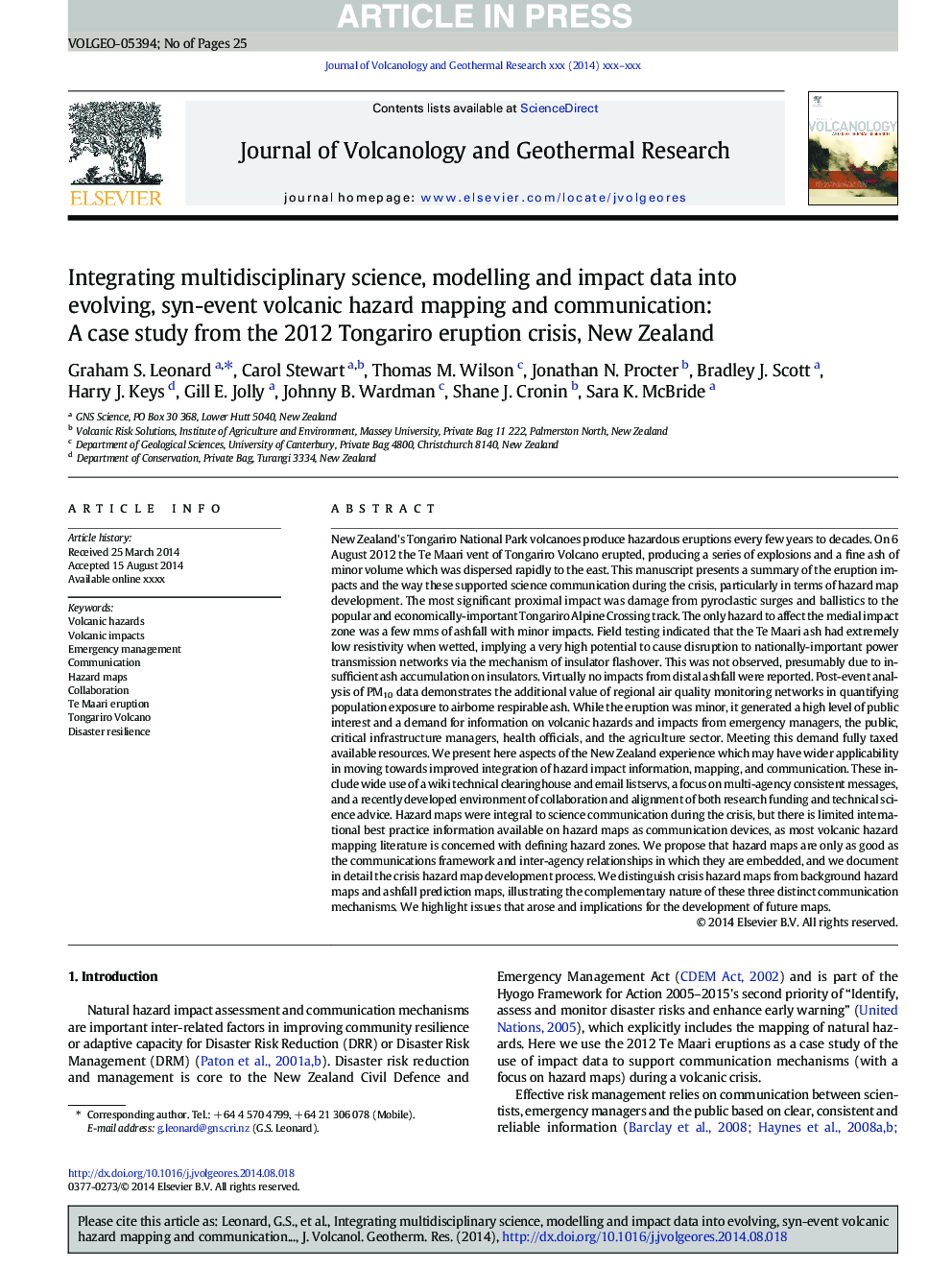| کد مقاله | کد نشریه | سال انتشار | مقاله انگلیسی | نسخه تمام متن |
|---|---|---|---|---|
| 6439669 | 1638336 | 2014 | 25 صفحه PDF | دانلود رایگان |
عنوان انگلیسی مقاله ISI
Integrating multidisciplinary science, modelling and impact data into evolving, syn-event volcanic hazard mapping and communication: A case study from the 2012 Tongariro eruption crisis, New Zealand
دانلود مقاله + سفارش ترجمه
دانلود مقاله ISI انگلیسی
رایگان برای ایرانیان
کلمات کلیدی
موضوعات مرتبط
مهندسی و علوم پایه
علوم زمین و سیارات
ژئوشیمی و پترولوژی
پیش نمایش صفحه اول مقاله

چکیده انگلیسی
New Zealand's Tongariro National Park volcanoes produce hazardous eruptions every few years to decades. On 6 August 2012 the Te Maari vent of Tongariro Volcano erupted, producing a series of explosions and a fine ash of minor volume which was dispersed rapidly to the east. This manuscript presents a summary of the eruption impacts and the way these supported science communication during the crisis, particularly in terms of hazard map development. The most significant proximal impact was damage from pyroclastic surges and ballistics to the popular and economically-important Tongariro Alpine Crossing track. The only hazard to affect the medial impact zone was a few mms of ashfall with minor impacts. Field testing indicated that the Te Maari ash had extremely low resistivity when wetted, implying a very high potential to cause disruption to nationally-important power transmission networks via the mechanism of insulator flashover. This was not observed, presumably due to insufficient ash accumulation on insulators. Virtually no impacts from distal ashfall were reported. Post-event analysis of PM10 data demonstrates the additional value of regional air quality monitoring networks in quantifying population exposure to airborne respirable ash. While the eruption was minor, it generated a high level of public interest and a demand for information on volcanic hazards and impacts from emergency managers, the public, critical infrastructure managers, health officials, and the agriculture sector. Meeting this demand fully taxed available resources. We present here aspects of the New Zealand experience which may have wider applicability in moving towards improved integration of hazard impact information, mapping, and communication. These include wide use of a wiki technical clearinghouse and email listservs, a focus on multi-agency consistent messages, and a recently developed environment of collaboration and alignment of both research funding and technical science advice. Hazard maps were integral to science communication during the crisis, but there is limited international best practice information available on hazard maps as communication devices, as most volcanic hazard mapping literature is concerned with defining hazard zones. We propose that hazard maps are only as good as the communications framework and inter-agency relationships in which they are embedded, and we document in detail the crisis hazard map development process. We distinguish crisis hazard maps from background hazard maps and ashfall prediction maps, illustrating the complementary nature of these three distinct communication mechanisms. We highlight issues that arose and implications for the development of future maps.
ناشر
Database: Elsevier - ScienceDirect (ساینس دایرکت)
Journal: Journal of Volcanology and Geothermal Research - Volume 286, 1 October 2014, Pages 208-232
Journal: Journal of Volcanology and Geothermal Research - Volume 286, 1 October 2014, Pages 208-232
نویسندگان
Graham S. Leonard, Carol Stewart, Thomas M. Wilson, Jonathan N. Procter, Bradley J. Scott, Harry J. Keys, Gill E. Jolly, Johnny B. Wardman, Shane J. Cronin, Sara K. McBride,